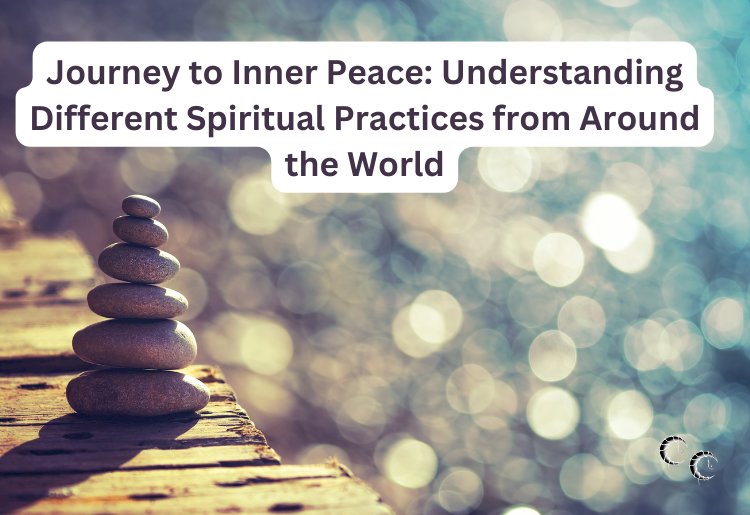Journey to Inner Peace: Understanding Different Spiritual Practices from Around the World

In our quest for inner peace and spiritual fulfillment, we often find inspiration and wisdom in the diverse spiritual traditions and practices that span the globe. From ancient wisdom traditions to modern spiritual movements, cultures around the world have developed unique pathways to connect with the divine, cultivate inner peace, and awaken to the deeper truths of existence. In this article, we'll explore a variety of spiritual practices from different cultures and traditions, each offering valuable insights and techniques for embarking on a journey to inner peace:
-
Meditation (Buddhism): Meditation lies at the heart of Buddhist practice, offering a pathway to self-discovery, mindfulness, and enlightenment. In Buddhist meditation, practitioners cultivate awareness and insight through techniques such as mindfulness, concentration, and loving-kindness meditation. By quieting the mind and observing the nature of thoughts and emotions, individuals can cultivate inner peace and awaken to the inherent wisdom and compassion within.
-
Yoga (Hinduism): Yoga is a spiritual practice with roots in Hinduism that integrates physical postures, breathwork, and meditation to promote holistic well-being and spiritual growth. Through the practice of yoga, practitioners seek to unite body, mind, and spirit, cultivating balance, strength, and flexibility on the physical level while also deepening self-awareness and connection to the divine.
-
Prayer (Christianity): Prayer is a central spiritual practice in Christianity, serving as a means of communion with God, seeking guidance, and offering gratitude and supplication. Through prayer, Christians cultivate a personal relationship with the divine, surrendering their concerns and desires while opening themselves to divine grace, guidance, and presence. Prayer can provide solace, strength, and a sense of connection to something greater than oneself.
-
Sufi Whirling (Islam): Sufi Whirling is a mystical practice within Islam that involves spinning in circles as a form of meditation and devotion. Practiced by Sufi mystics, Sufi Whirling aims to induce a state of trance-like ecstasy and union with the divine. Through the rhythmic movement and surrender of the self, practitioners seek to transcend the ego and experience a direct connection with the divine source of all existence.
-
Shamanic Journeying (Indigenous Traditions): Shamanic journeying is a spiritual practice found in indigenous traditions around the world, including Native American, African, and Siberian cultures. Through rhythmic drumming, chanting, or other methods, shamans enter altered states of consciousness to communicate with spirits, receive guidance, and facilitate healing for individuals and communities. Shamanic journeying offers a direct experience of the interconnectedness of all life and the sacredness of the natural world.
-
Tai Chi (Taoism): Tai Chi is a Chinese martial art and spiritual practice that combines slow, deliberate movements with focused breathing and mindfulness. Rooted in Taoist philosophy, Tai Chi cultivates harmony, balance, and flow, aligning body, mind, and spirit with the rhythms of nature. Through the practice of Tai Chi, individuals can cultivate inner peace, vitality, and a deep sense of connection to the Tao, or the underlying principle of existence.
-
Mindfulness (Secular): Mindfulness is a secular spiritual practice that draws on Buddhist meditation techniques to cultivate present-moment awareness and nonjudgmental acceptance. Mindfulness practices, such as mindful breathing, eating, and walking, encourage individuals to pay attention to their thoughts, feelings, and sensations with curiosity and compassion. By cultivating mindfulness, individuals can reduce stress, enhance well-being, and cultivate inner peace in the midst of daily life.
-
Kabbalah (Judaism): Kabbalah is a mystical tradition within Judaism that explores the nature of God, creation, and the soul. Through practices such as meditation, contemplation, and the study of sacred texts, Kabbalists seek to deepen their understanding of the divine mysteries and awaken to the hidden truths of existence. Kabbalah offers a pathway to spiritual growth, transformation, and union with the divine essence.
-
Qigong (Chinese Medicine): Qigong is a Chinese spiritual practice that combines movement, breathwork, and visualization to cultivate vitality, harmony, and balance within the body and mind. Through gentle, flowing movements and focused intention, practitioners of Qigong harmonize the flow of qi, or life force energy, through the body's energy channels, promoting health, well-being, and spiritual growth.
-
Ayahuasca Ceremony (Amazonian Shamanism): Ayahuasca ceremony is a traditional indigenous practice in the Amazon rainforest that involves consuming a psychoactive brew made from the Ayahuasca vine and other plants. Under the guidance of a shaman, participants enter into altered states of consciousness to gain insight, healing, and spiritual awakening. Ayahuasca ceremony offers a profound journey of self-discovery, confronting the shadow aspects of the self and connecting with the wisdom of the natural world.
In conclusion, the journey to inner peace is a universal quest that transcends cultural, religious, and spiritual boundaries. By exploring the diverse spiritual practices from around the world, we can gain valuable insights, techniques, and perspectives for cultivating inner peace, spiritual growth, and connection with the divine. Whether through meditation, prayer, yoga, or shamanic journeying, each spiritual practice offers a unique pathway to awakening to the deeper truths of existence and experiencing the profound peace and fulfillment that arise from living in alignment with our highest spiritual aspirations.






























